
Bike Spokes: The Complete Guide
spokes play a crucial role in the performance, durability, and overall ride quality of any bicycle. Though they may appear to be simple, thin rods connecting the hub to the rim, spokes are in fact the backbone of a wheel’s strength, stability, and efficiency. For cyclists seeking high-performance upgrades, our Top-fire carbon fiber spokes provide ultra-lightweight design and exceptional stiffness, enhancing both speed and responsiveness on the road or trail.
This article explores the multifaceted world of bike spokes—from their essential function and various types to the materials used in their construction and the lacing patterns that determine wheel tension. It also provides practical maintenance tips and guidance on selecting the right spokes for different cycling disciplines. For those seeking a smoother, more responsive ride, gaining a deeper understanding of bike spokes is an ideal starting point.
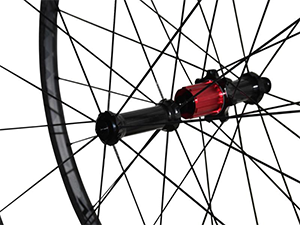
Spokes are more than just a connection between the hub and rim; they are vital to a bike's performance, comfort, and durability. Their impact is reflected in three key areas.
One of the spokes' most important functions is to evenly distribute the rider's weight throughout the wheel. Rather than concentrating stress on a single point, spokes distribute the load between the hub and rim. This balanced support helps prevent rim damage and keeps the wheel strong, even during high-impact riding or when subjected to heavy loads.
Proper spoke tension is critical to wheel stability. When tension is balanced across all spokes, the wheel stays straight. However, if even one spoke is too loose or too tight, the wheel can wobble, affecting handling and safety. Regularly checking tension helps maintain a smooth and predictable ride.
Spokes also help absorb vibrations and minor shocks from the road or trail. Their ability to flex slightly under pressure reduces shock forces on the rider, improving comfort and reducing fatigue. This is especially beneficial on rough terrain, where stability and traction are crucial.
The spoke head is the flattened, mushroom-shaped end that fits into the hub. It anchors the spoke securely in place, allowing it to transfer torque and rotational force from the hub to the rim. Damage or cracking at the spoke head can lead to immediate failure and compromised wheel performance.
Located just beside the head, the elbow forms a 90-degree angle that allows the spoke to exit the hub flange and align with the rim. This bend is a high-stress area and is one of the most common points where spoke breakage occurs—especially if spoke tension is uneven or the wheel is poorly built.
The shaft is the long, central portion of the spoke, typically constructed from stainless steel for strength and corrosion resistance. High-end wheels may use double-butted (thinner in the middle), bladed (aerodynamic), or carbon fiber spokes to reduce weight and wind resistance. The shaft must strike a careful balance between stiffness and flexibility to maintain proper wheel alignment and shock absorption.
At the end of the shaft is a threaded section that allows the spoke to connect with the nipple. This thread is essential for adjusting spoke tension, which directly influences the trueness and structural stability of the wheel.
The nipple is a small but vital component that threads onto the end of the spoke and sits within the rim. It functions similarly to a nut and can be turned with a spoke wrench to tighten or loosen tension. Proper adjustment of the nipple ensures the wheel remains round and balanced, allowing for precise performance and safe riding.
J-bend spokes are the most common type you’ll find on bikes. Named after the small“J”-shaped bend near the spoke head, they’ve been the industry standard for decades.
Pros:They’re widely available, cost-effective, and easy to replace. Almost any bike shop will have J-bend spokes in stock, making repairs quick and affordable.
Cons: That bend is a stress point. If the spoke tension isn’t properly balanced, the elbow can be more prone to fatigue and breakage over time.
Typical Applications:J-bend spokes are used in everything from entry-level commuter bikes to rugged mountain bikes. They're a go-to for general-purpose wheels.
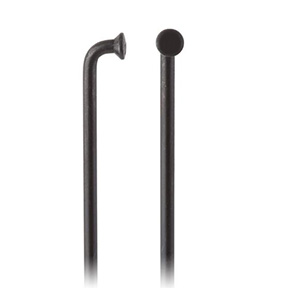
Straight-pull spokes remove the bend entirely, offering a direct, linear connection between the hub and rim.
Differences from J-Bend: Without that 90-degree angle, there’s less flex and fewer weak points—giving you a stronger spoke that holds tension more evenly.
Aerodynamic & Tension Benefits: These spokes often allow for higher and more balanced tension, which can improve power transfer and wheel stiffness. Plus, with no bend catching airflow, they're slightly more aerodynamic.
Compatibility Issues: This type requires specific hubs designed for straight-pull spokes. That means fewer options and usually a higher cost for replacements.

Bladed spokes, also known as aero spokes, are flattened or oval in shape to cut through the wind more efficiently.
Reduced Wind Resistance: These are engineered for aerodynamics. By reducing drag, they can give competitive riders a real edge—especially in time trials or road races.
Used in Racing: Professional road bikes and triathlon setups often rely on bladed spokes where every watt and second count.
Construction and Installation: Bladed spokes must be aligned correctly during wheel building so the flat side faces the wind. Many require special tools for installation and truing, making them less beginner-friendly.
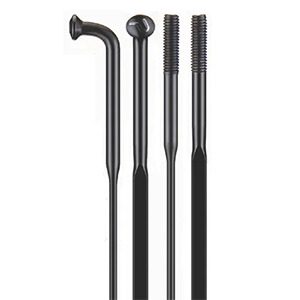
When it comes to bike spokes, material matters—a lot. The right spoke material can enhance strength, reduce weight, improve ride quality, or maximize aerodynamic performance.
Stainless steel is by far the most popular spoke material in the cycling world—and for good reason. It’s strong, durable, and corrosion-resistant, making it ideal for everything from commuter bikes to high-performance road wheels. Stainless steel spokes strike a balance between reliability and affordability, and they maintain consistent tension over time. Most wheel builders and mechanics trust stainless steel for its proven track record and easy availability.
Aluminum spokes are lighter than steel, but that weight saving comes with a cost—they’re less durable and more prone to fatigue and breakage. Aluminum is softer, which can lead to deformation or cracking under stress. For this reason, aluminum spokes are rare and mostly found on niche or experimental builds. They may offer slight weight benefits, but they require careful installation and are not recommended for heavy-duty use.
Titanium offers the best of both worlds: lighter than steel, yet stronger than aluminum, and with impressive corrosion resistance. It also has a slightly elastic quality that improves ride comfort. However, this premium performance comes at a premium price. Titanium spokes are expensive and harder to find, often reserved for custom builds or high-end performance wheels.
Carbon fiber is the cutting edge of spoke material technology—ultra-light, incredibly stiff, and designed for maximum aerodynamic efficiency. Carbon spokes are typically found in high-end racing wheels, where every second counts. They’re not threaded like metal spokes; instead, they’re molded and integrated into proprietary hub systems. This makes them difficult to repair or replace and limits their use to specific wheelsets.
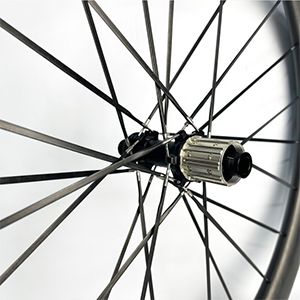
Spoke count is one of the most overlooked yet important aspects of a bicycle wheel. It directly influences the wheel’s strength, weight, and intended use. More spokes generally mean better load distribution and durability, while fewer spokes reduce weight and improve aerodynamics.
Most modern bicycles feature wheels with 24, 28, 32, or 36 spokes. Each configuration serves a specific purpose:
24 spokes: Common on high-end road bikes and race wheels. Fewer spokes mean less wind resistance and reduced weight, ideal for speed and climbing. However, these wheels trade off some strength and may not be suitable for heavier riders or rough terrain.
28 spokes: A versatile middle ground often found on performance road bikes. They offer a good mix of aerodynamics and durability, making them suitable for both training and racing.
32 spokes: The traditional standard for many bikes, including touring and gravel models. These wheels provide excellent strength and reliability for long-distance rides or loaded touring setups
36 spokes: Designed for maximum strength. Found on mountain bikes, tandem bikes, and cargo bikes, they’re ideal for riders who need maximum load capacity and durability.
Road Bikes: 24 to 28 spokes are typical for lightweight performance. Racers often choose 24 for speed, while endurance riders may opt for 28 for extra support.
Gravel and Cyclocross Bikes:28 to 32 spokes offer the durability needed for mixed terrain without adding excessive weight.
Mountain Bikes: Usually 32 or 36 spokes, depending on the riding style. Aggressive downhill or enduro riders often favor 36 spokes for maximum impact resistance.
Touring and Cargo Bikes: Always go for 36 spokes. When carrying gear or passengers, structural strength is non-negotiable.
Electric Bikes (E-bikes): Typically 36 or more spokes to support the added weight of the motor and battery system.
The way spokes are arranged—known as the lacing pattern—greatly affects a wheel's strength, responsiveness, and durability. Lacing isn't just a matter of aesthetics; it's about physics, tension, and function.
Radial lacing is the most direct and minimalist spoke pattern. In this design, spokes run straight from the hub to the rim without crossing any other spokes.
Lightweight and Aerodynamic: Because radial lacing uses the shortest possible spoke length, it reduces weight and offers less wind resistance. This makes it a favorite for performance-focused front wheels on road bikes.
Best for Front Wheels Without Disc Brakes: Radial lacing isn’t designed to handle high torque. That’s why it’s almost exclusively used on front wheels without disc brakes. On rear or disc-brake wheels, the lack of crossing spokes can lead to spoke pull-out under stress.
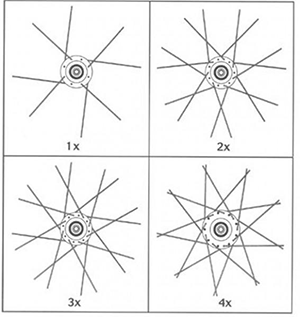
These patterns refer to how many times each spoke crosses over other spokes on the same side of the hub. The more crossings, the longer the spoke and the more force it can help manage.
2-Cross (2X): Each spoke crosses two others. This pattern offers a balance between lightness and strength. It’s often used on lightweight wheels that still need to handle some torque—like in cyclocross or gravel riding.
3-Cross (3X): The most common pattern across road, gravel, and mountain bikes. Each spoke crosses three others, providing excellent strength, even tension, and shock absorption. It’s the go-to choice for durability without excessive weight.
4-Cross (4X): Used primarily in heavy-duty applications like tandem, cargo, or downhill bikes. The longer spoke path and multiple crossings make the wheel more robust but add weight and complexity.
Road Cyclists: Radial (front) and 2X or 3X (rear) for a mix of speed and reliability.
Gravel and Cyclocross: 3X for balance between strength and responsiveness.
Mountain Bikers: 3X or 4X, depending on how aggressive the terrain and riding style are.
Touring and Cargo: Always 3X or 4X to ensure maximum load-bearing capacity.
Selecting the right spokes is not just about wheel aesthetics—it's a crucial decision that influences a bike’s performance, durability, and safety.
Riding Style: Aggressive riders who sprint, climb, or take on rough terrain require stronger, more durable spokes—often with higher spoke counts and more robust lacing patterns. Casual commuters or recreational cyclists can prioritize weight savings and aerodynamics instead.
Bike Type: Each type of bike has unique demands:
Road bikes benefit from lightweight, low-spoke-count wheels (often 24–28) for speed and efficiency. Cyclists aiming for top performance may consider Top-fire carbon spokes to enhance aerodynamics and reduce weight.
Mountain bikes require 32–36 spokes to handle shock, impact, and rough conditions.
Gravel bikes sit in the middle, usually with 28–32 spokes for both performance and durability.
E-bikes place extra stress on wheels due to motorized power and added weight, making 36 spokes or more ideal.
Rider Weight: Heavier riders need wheels with more spokes and stronger materials to avoid spoke fatigue and wheel flex.
Terrain: Rough roads, trails, or loaded touring require strong, impact-resistant wheels. In such cases, stainless steel spokes with 3-cross lacing patterns are a reliable choice.
There's a direct correlation between spoke count and wheel strength. More spokes mean better load distribution and greater durability, but at the cost of added weight and slightly more aerodynamic drag. Fewer spokes reduce weight and improve speed, but sacrifice resilience and may be more prone to failure under stress.
Spoke breakage is often the result of a combination of factors rather than a single flaw. The most common causes include:
1. Metal fatigue from years of use or improper tension.
2. Corrosion, especially on lower-quality spokes or in wet, salty environments.
3. Poor wheel building, such as uneven spoke tension or misaligned lacing patterns.
4. Impact damage from potholes, jumps, or crashes.
1. Spoke fatigue doesn’t happen overnight. There are subtle signs cyclists can watch for:
2. A "ting" sound while riding may indicate a spoke snapping or shifting under stress.
3. Wobbling wheels or rubbing against brake pads can signal uneven tension or a broken spoke.
4. Visible cracks or corrosion near the spoke head or nipple area.
Regular inspection and tension checks, especially after long rides or impacts, can prevent bigger issues down the road.
1. Regular inspection is the first step to preventing spoke problems. Experts recommend checking spoke tension at least once a month—more often for off-road, touring, or e-bike riders.
2. Spin the wheel and look for side-to-side wobbles, which may indicate uneven spoke tension.
3. Squeeze pairs of spokes together with your fingers. They should all feel similarly firm; if one feels much looser, it may need attention.
4. Listen: Healthy spokes emit a clear“ping”when plucked. A dull or flat sound can signal tension loss or fatigue.
1. Minor adjustments can be made with a spoke wrench. Tighten or loosen the nipple slightly to restore balance, but always in small increments.
2. For more serious misalignment, or if multiple spokes are affected, it’s best to visit a professional wheel builder. Improper tensioning can cause more harm than good.
1. Use a soft brush or cloth with warm, soapy water to clean around the spokes and nipples.
2. Avoid harsh degreasers or solvents, as they may damage protective coatings.
3. Rinse thoroughly and dry with a clean cloth.
Bike spokes are more than just wheel components—they’re the silent partners in every ride, whether you're crushing trails or chasing speed. Understanding spoke types, materials, tension, and patterns helps you get the most out of your wheels. Regular maintenance and thoughtful upgrades can go a long way in improving ride quality and safety.
1. How often should I check my bike spokes for tension?
At least once a month, especially if you ride frequently or over rough terrain.
2. Can I ride with a broken spoke?
It’s not ideal, but you can ride short distances carefully. Get it fixed ASAP to avoid rim damage.
3. Are more spokes always better for strength?
Not always. More spokes = more weight. It depends on your riding style and the terrain.
4. What’s the best spoke material for mountain biking?
Stainless steel is the go-to for its durability and shock absorption.
5. Is wheel truing the same as adjusting spoke tension?
They’re closely related. Truing involves tightening/loosening spokes to straighten the wheel.
Categorías
Nuevo blog
Derechos de autor © 2025 Top-Fire Carbon Technology Co., Ltd. Reservados todos los derechos. Poder por

Red IPv6 admitida